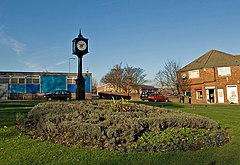Aspull
| Aspull | |
|---|---|
 Aspull Clock | |
Location withinGreater Manchester | |
| Population | 4,977 |
| OS grid reference | SD611082 |
| Metropolitan borough | |
| Metropolitan county | |
| Region | |
| Country | England |
| Sovereign state | United Kingdom |
| Post town | WIGAN |
| Postcode district | WN2 |
| Dialling code | 01942 |
| Police | Greater Manchester |
| Fire | Greater Manchester |
| Ambulance | North West |
| UK Parliament | |
Aspullis a village in theMetropolitan Borough of Wigan,inGreater Manchester,England.Historicallyin Lancashire, Aspull, along withHaigh,is surrounded by greenbelt and agricultural land, separated fromWesthoughton,on its southeast side, by a brook running throughBorsdane Wood.The ground rises from south to north, reaching 400 feet (122 m), and has views towardsWinter Hilland theWest Pennine Moors.It has a population of 4,977.
Aspull was once a centre of mining andtextile manufacture,though little evidence of this can be seen in the village today.Haigh Country Parkestate lies to the west.
History
[edit]Early history
[edit]The earliest notice of Aspull is that contained in the survey of 1212, when, as one plough-land, it formed part of the Childwall fee held by Richard son of Robert de Lathom, under the lord of Manchester. The fee was a composite one of 6½ plough-lands (of which Aspull formed one), held chiefly by Richard de Lathom, and partly by Roger de Samlesbury and Alexander de Harwood.
In 1302 Richard deInce,as son and heir of Henry deSefton,and Adam deHindley,were found to hold Aspull, as the eighth part of a knight's fee, directly of Thomas Grelley. From this time the lordship has been held with the adjacent Ince by the families of Ince and Gerard in succession; until Aspull was sold to theEarl of CrawfordandBalcarres,lord ofHaigh.
Hindley Hall, in Aspull, the residence of the Hindleys, became the property of James, a younger son ofRobert DukinfieldofCheshire.In the 18th century it was acquired by the Leighs of Whitley Hall,Wigan,and Sir Robert Holt Leigh lived here till his death in 1843. His estates then passed for life to his cousinThomas Pemberton,who took the name of Leigh, and made Hindley Hall his residence; he was raised to the peerage as Baron Kingsdown in 1858.
The hearth tax roll of 1666 shows that 135 hearths were charged. The most considerable houses were those of Richard Green, nine hearths; Peter Orrell and James Dukinfield, eight each; Major Rigby and Thomas Molyneux, seven each; and Edward Gleast, six.
St. Elizabeth'sC of EChurch was built in 1882 by Roger Leigh. The patronage is vested in trustees. There are twoMethodistchapels. In 1858 theRoman Catholicchurch ofOur Lady of the Immaculate Conceptionwas erected.
Coal
[edit]Cannel coalwas found in Aspull. There were several large collieries dating back to the 18th century, alsomalt kilnsand acotton mill.In 1896 the Crawford, Kirkless, Moor and Woodshaw Pits in the township belonging theWigan Coal and Iron Companyemployed over 1,000 workers.[1]Aspull's long history of mining left a legacy of old mineshafts, water drainage tunnels (soughs) and abandoned mine workings.
TheGreat Haigh SoughinHaighCountry Park discharged iron rich minewater into the Yellow Brook discolouring the brook andRiver Douglasdownstream with ochre deposits. In 2004 theCoal Authorityprovided apassive treatment plantin a scheme costing £750,000. Work was undertaken by Ascot Environmental who built a pumping station, pipelines, settlement lagoons, reedbeds and landscaped the site. The scheme has improved the water quality removing the discolouration and allowed fish to populate the brook.[2]
The coal-mining tradition lives on in the name of the "Collier's Arms" pub on Wigan Road, which has a date plaque of 1700[1].
Geography
[edit]Aspull is on a crossroads. The principal road is to the north-east/south-west,Blackrodto Wigan. Another road runs north-west/south-east,Standishto theA6 road.TheLeeds and Liverpool Canalpasses through the western corner of the township. Aspull Moor lies in the northern half of the village.
The nearest railway station is atHindleyalthoughBlackrodis only a few yards further distant. Hindley has the more frequent service, whilst Blackrod has the faster service to Manchester. Whilst having colliery (goods) railways Aspull has never had a central railway station of its own. There was, however, on the line from Wigan to Chorley (via Hindley), a station namedDicconson Lane & Aspullsome distance from Aspull; that was closed in 1956, before closure of the entire line to passengers in 1960 and to goods in 1966.
Sport
[edit]The town'srugby unionclub, Aspull RFC, currently fields 3 senior teams. The 1stXV plays in the Counties 1 ADM Lancashire & Cheshire, the 2nd XV plays in the Group 1 of the ADM Combination league and the 3rd XV play in NOWIRUL Simply Lifetime Mortgages Division 3 Central of Halbro NW Leagues.Also Aspull juniors FC who have 22 age related teams and an excellent girls section.
The town is home to theAspull Olympic Wrestling Club,known internationally as "The Snake Pit", one of the last gyms to teach authentic catch wrestling.
See also
[edit]References
[edit]- ^Wigan Coal & Iron Co. Ltd.,Durham Mining Museum,retrieved7 February2011
- ^Aspull Sough Minewater Treatment Scheme,The coal Authority, archived fromthe originalon 12 September 2010,retrieved7 February2011
Bibliography 'Townships: Aspull', A History of the County of Lancaster: Volume 4 (1911), pp. 118–22.
External links
[edit]![]() Media related toAspullat Wikimedia Commons
Media related toAspullat Wikimedia Commons
- Aspull:historical and genealogical information atGENUKI.
- Wigan World
- Aspull RFC
- Aspull Broadband
- All about Aspull
- Aspull Church Primary School
- Our Lady's R.C. Primary School
- Aspull Civic Hall
- Haigh Country Park

